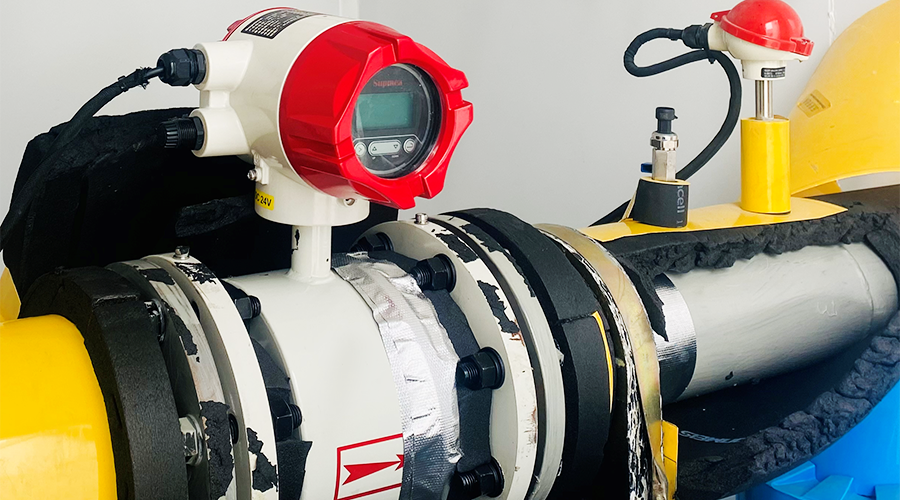Electromagnetic flowmeters are commonly used in cooling systems due to their accuracy and reliability. Here are some frequently asked questions about these devices:
What is a cooling system?
A cooling system is an essential component of any machine or device that generates heat during its operation. It is designed to regulate the temperature of the system and prevent it from overheating, which can cause damage or even complete failure of the equipment. A cooling system typically consists of a coolant, a pump, a radiator, and a fan.
The coolant absorbs the heat generated by the system and carries it to the radiator, where it is dissipated into the surrounding air by the fan. The pump circulates the coolant through the system, ensuring that it reaches all the areas that need to be cooled. Cooling systems are used in a wide range of applications, from cars and trucks to power plants and data centers. They are critical to the safe and efficient operation of these systems, and must be carefully designed and maintained to ensure their effectiveness.
Cooling systems are used in a variety of industries, including power generation, chemical processing, and manufacturing. These systems are designed to remove heat from equipment and processes to maintain optimal operating conditions. The flow rate of the cooling liquid is a critical parameter that needs to be monitored and controlled to ensure efficient and effective cooling.
What is an electromagnetic flowmeter?
An electromagnetic flow meter is a device that measures the flow rate of conductive liquids, such as water, by using a magnetic field to induce a voltage in the fluid. The voltage is then measured and used to calculate the flow rate.
How does an electromagnetic flow meter work in a cooling system?
An electromagnetic flow meter is a device used in cooling systems to measure the flow rate of a conductive fluid. The device works on the principle of Faraday’s law of electromagnetic induction, which states that a voltage is induced in a conductor when it moves through a magnetic field.
In a cooling system, the conductive fluid (usually water) flows through a pipe that contains a magnetic field generated by the flow meter. As the fluid flows through the pipe, it induces a voltage in the electrodes located on either side of the magnetic field. The voltage generated is proportional to the flow rate of the fluid, and this information is used to calculate the flow rate of the fluid.
The accuracy of an electromagnetic flowmeter is dependent on several factors, including the conductivity of the fluid, the strength of the magnetic field, and the distance between the electrodes. The device is typically calibrated to account for these factors and provide accurate measurements.
Overall, an electromagnetic flowmeter is a reliable and accurate device for measuring the flow rate of conductive fluids in cooling systems. Its ability to measure flow rates without obstructing the flow of the fluid makes it a popular choice in many industrial applications.
What are the advantages of using an electromagnetic flow meter in a cooling system?
An electromagnetic flow meter offers several advantages when used in a cooling system. Firstly, it provides accurate and reliable measurement of the flow rate of the coolant, which is crucial in maintaining the efficiency and performance of the cooling system. The flow meter is capable of measuring the flow rate of conductive fluids such as water and glycol-based coolants, without being affected by changes in temperature, pressure or viscosity.
Another advantage of using an electromagnetic flowmeter is its low maintenance requirements. Unlike other types of flowmeters, it has no moving parts that can wear out or become clogged. This means that it can operate continuously without the need for frequent maintenance or calibration, reducing downtime and associated costs.
In addition, an electromagnetic flowmeter is highly versatile and can be used in a wide range of cooling system applications, including HVAC systems, industrial cooling towers, and chiller plants. It is also easy to install and can be integrated into existing systems with minimal disruption.
In short, the use of an electromagnetic flow meter in a cooling system provides accurate and reliable measurement, low maintenance requirements, and versatility, making it an ideal choice for many applications.
What factors should be considered when selecting an electromagnetic flowmeter for a cooling system?
When selecting an electromagnetic flowmeter for a cooling system, there are several factors that should be taken into consideration. Firstly, the size and flow rate of the system must be determined in order to choose an appropriate meter size. The material of the meter should also be considered, as it must be compatible with the fluid being measured.
Accuracy requirements are another important factor. The flow meter must be capable of measuring flow rates within the required range and with the desired level of precision. Additionally, the meter’s output signal and communication protocols must be compatible with the data acquisition system being used.
Installation considerations should also be taken into account. The meter should be installed in a location that allows for proper flow conditions and accessibility for maintenance. The availability of power and grounding requirements should also be evaluated.
Finally, cost and maintenance requirements should be considered. The initial cost of the meter and its ongoing maintenance requirements should be weighed against the benefits of accurate flow measurement for the cooling system. It may be beneficial to invest in a higher-quality meter if it will provide more accurate measurements and require less maintenance over time.
Selecting the right electromagnetic flowmeter for a cooling system requires careful consideration of several factors, including size, material, accuracy, installation, and cost. By evaluating these factors and selecting a meter that meets the specific needs of the system, accurate and reliable flow measurements can be achieved.
How often should an electromagnetic flowmeter be calibrated?
Electromagnetic flowmeters are an essential tool for measuring the flow rate of conductive liquids in a variety of industrial applications. To ensure accurate readings, it is crucial to calibrate these devices regularly. The frequency of calibration depends on various factors, such as the specific application, the environment, and the manufacturer’s recommendations.
In general, electromagnetic flowmeters should be calibrated at least once a year. However, some applications may require more frequent calibration due to harsh operating conditions or critical process requirements. For instance, flowmeters used in the food and beverage industry typically require frequent calibration to ensure compliance with hygiene standards. On the other hand, flowmeters used in less critical applications may only need calibration every two or three years.
It is also important to note that electromagnetic flowmeters can drift over time due to factors such as temperature changes, electrical interference, and mechanical wear. Therefore, it is essential to perform regular checks and adjustments to maintain accuracy between calibrations.
The frequency of calibration for electromagnetic flowmeters depends on several factors and should be determined based on the specific application and manufacturer’s recommendations. Regular calibration and maintenance are crucial for ensuring accurate and reliable flow measurements and preventing costly downtime or errors in the production process.
In conclusion, electromagnetic flowmeters are an excellent choice for measuring the flow rate of cooling water in a wide range of applications. By selecting the appropriate flow meter and calibrating it regularly, users can ensure accurate and reliable measurements that help maintain optimal system performance.
Post time: Apr-27-2023

